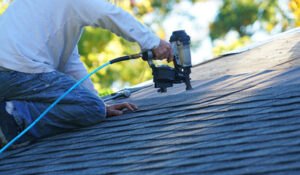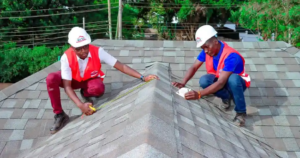Roofers install, repair, and replace roofing materials. They are skilled in measuring and cutting roofs, laying down underlayment, and attaching shingles to create watertight and durable structures.

Many roofers collaborate with other construction professionals, such as carpenters and electricians. They must be able to work well as part of a team and adapt to changes in project plans.
Residential roofers specialize in repairing and installing the roofing on single- or multi-family homes. They may also provide roof inspections and guidance in selecting the best roofing materials for a home. Residential roofers must be skilled in the construction of roofing systems and have knowledge of building codes and regulations in their state. Some states require roofers to obtain licensing, and homeowners should verify a roofer’s insurance policies to ensure that workers’ compensation and liability coverage are in place.
Storm chasers are roofers that focus on working with insurance companies and completing roofing jobs as quickly as possible after a severe weather event. These roofers typically target neighborhoods with high incidence of hail or wind damage and offer to handle the entire insurance claim process on behalf of the homeowner. This makes them a convenient option, but it’s important to understand that they are not focused on customer service and may not return calls or emails after the job is completed.
If you choose to work with a retail sales roofer, make sure to get a detailed contract that includes safety protocols, cleanup methods, payment terms and schedules. The contract should also specify whether the roofer will supply in-house financing or expect the homeowner to pay for the entire project upfront. In addition, the contract should detail workers’ compensation and liability insurance. If a roofer does not carry these insurance policies, you should consider hiring another company.
Commercial
Commercial roofers focus on buildings larger than homes. They may work on large warehouses, shopping centers, office buildings and other large structures that require a unique roofing system. Commercial roofers need to be familiar with a wider variety of materials, including asphalt shingles, metal standing seam roofs and flat rubber roofs, like EPDM or PVC.
Commercial roofing is also more complex than residential roofing. Commercial roofers need to be able to plan and execute a larger project that involves more people, more workers and multiple phases. Often, they must coordinate with building managers to avoid disrupting daily operations or creating safety hazards. In addition, the size of a commercial building often requires special equipment to hoist materials and other materials onto the roof.
Many commercial clients have specific demands before they even call for a quote, Skujins says. He says some work with engineering firms, roof consultants or property managers who insist on a certain type of roof within certain specifications and with a particular warranty.
It’s important for a commercial roofer to have strong communication skills and be dedicated to service, he says. Having these qualities can help them build and maintain long-term relationships with their clients, which is beneficial to both parties. For example, he notes that some of his clients have been with him for more than 20 years, and he says he wants to continue working with them because it makes him happy to see the company he founded grow over time. It’s equally important for a commercial roofer to be honest with his clients and not oversell his services. Otherwise, the client may be disappointed in the end. Also, cutting corners on materials can result in expensive problems down the road.
Industrial
Roofers who specialize in roofing services for industrial buildings install, repair, and maintain roofs that often require more robust materials and designs because of heavy equipment stored or operated on the building’s rooftop. They work with a variety of industrial roof types, including metal panels, single-ply membranes, and built-up roofing systems, as well as shingle and tile systems. They also conduct regular maintenance tasks, such as performing roof inspections, repairing leaks, and cleaning gutters and drainage systems.
The roofs of industrial buildings are typically flat or slightly pitched, whereas residential roofs have more dramatic slopes to accommodate rainwater runoff and other weather elements. As a result, industrial roofers must use different tools and techniques than residential roofers to ensure optimal results. They may also need to address specific environmental requirements, such as working in a salt-laden environment or dealing with other chemicals that can degrade certain types of roofing material.
Like other construction workers, industrial roofers face the risk of falls and injuries while on the job. To mitigate these risks, they must follow strict safety guidelines and practices, and many work at heights that require fall protection equipment. They must also be trained to use ladders and scaffolding safely.
Specialty
When you hire a roofer, it is important to find one that specializes in the type of roofing system that you have. Just as an artist may focus on a particular style or craft, roofers develop expertise in different types of roofing systems. For instance, a metal roof is very different from a shingle roof. The materials and installation techniques required for each type of roof are also very different. In most cases, a specialist roofer will be able to offer you the best quality and service for your specific needs.
There are a number of ways to determine whether or not a roofing contractor is licensed in your area. Generally, State licensing requirements include a background check, experience in the industry, passing a trade exam, insurance, and in some instances a bond. In addition, local governments might have licensing requirements for roofing contractors. The website of your county or city is a good place to start to see what, if any, requirements there are for roofing contractors in your area.
In some states, including Alaska and Washington, you must register as a Specialty Contractor to do roofing work. This process includes passing a trade exam and providing proof of liability insurance and workers’ compensation. You will also need to provide your state license number and the name of an endorser, who is a registered general contractor in the state.
You should look for a roofer with plenty of experience and a solid track record. A good way to do this is by reading reviews. Many websites such as Google, Angie’s List, and Home Advisor host reviews of contractors. In addition, you can contact the contractor directly and ask for references from past clients.
Choosing the right roofer is essential for ensuring your home or commercial building’s safety and longevity. In order to ensure the highest quality, it is a good idea to select a roofer that is IKO ROOFPRO certified. This certification is a mark of excellence that shows the contractor is committed to training and advancing their skills. It also means that the roofer is up to date on the latest roofing technology and practices.
